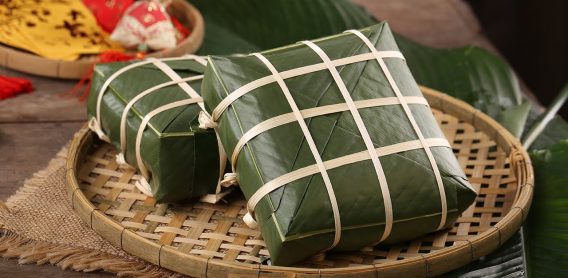The glutinous rice cake is a common rustic food of Vietnam, especially during the New Year holiday. Let’s discover how Banh Chung becomes an icon of such an occasion.
Banh Chung, or sticky rice cake, is one of the wonders of Asian cuisine presented in Vietnam. People may love its taste but may not know how the cake is made? And how it represents an iconic symbol of New Year Day in Vietnam?

Ever since the lunar month of December, local residents in many cities of Vietnam gather to prepare Banh Chung. They stock up firewood and green leaves to steam and wrap the cakes.
In the north, a traditional trade village of making rice cake, like Bo Dau, Dong, Tranh Khuc, can preserve and deliver up to 9,000 cakes in the peak time. This business requires tremendous efforts.
It is Banh Tet that they call in the south. Banh Tet is a cylindric glutinous rice cake available in meat or banana fillings.
The origin of sticky rice cakes
Back in the early civilization of Vietnam, there was a king named Hung Vuong the 6th who intentionally picking one heir to keep ruling the reign. But among 21 princes, it was impossible to determine. So, the King held a cooking contest in the new year and declared to choose the one who wins to be the next ruler. The throne would belong to the prince who brings the dish that satisfies the King.
Most of the sons rushed to access the mountains and recess the sea to seek ambrosia and unusual food. Meanwhile, Lang Lieu, the 18th son, the poorest and loneliest, was desperate to be unable to afford exotic meals.
One day in his dream, a fairy came and taught him how to concoct Banh Chung and Banh Day. On the day of the contest, Lang Lieu presented the cakes.
To everyone’s surprise, he explained the meaning of his food. Banh Chung is square, symbolizes the earth, while Banh Day is round and white, reflects the sky. At the greatest satisfaction, Emperor Hung declared Lang Lieu the winner and the new ruler of the kingdom.
Since then, Banh Chung and Banh Day have become indispensable offerings in ancestor worship rituals of Tet. It is to express the gratitude and devotion of “Think of the man who planted the tree” of descendants to grandparents and parents.
Sticky rice cakes in Vietnam new year holiday
Banh Chung has a delicate, unique, and creative taste. It’s not only imbued with national identity but also exceptional in materials and packaging. Rice represents the wet, tropical, hot, and humid rice culture. It reflects the national identity of Vietnam or Southeast Asia.

As for Chinese people, they prefer to make cakes from wheat flour, or Indians opt for millet. But for Banh Chung, stickiness is the flagship. The special and also very unique feature of the cooking of Banh Chung comes from the steaming time, rather than boiling. It can take up to 10-12 hours for cakes to get cooked inside out.
Despite being called glutenous rice, Banh Chung is free of gluten. It contains amylopectin derived from starch. That makes the cake suitable for those lovers of gluten-free food.
Sticky rice cakes in the north
Banh Chung is an indispensable dish in every tray of rice on Tet. Over thousands of years, the memories and images of making Banh Chung have delved in mind of generations of Vietnamese people.

Usually, Vietnamese families have a habit of wrapping cakes around 27-28 Lunar New Year. This is the time when families finish work, take a break after a hard year, to prepare everything for their ancestral rice trays on Tet holiday.
It is the nights when bordering on the cold New Year’s Eve; family members are staying up all night watching the pot of Banh Chung next to the fire. They share stories of the urban life, concerns, and also happiness by the burning red charcoal and laugh.
Sticky rice cakes in the south
In the southern part of the country, Banh Chung has a variation in shape, but the taste stays similar and is called Banh Tet. Notably, while Banh Chung is square, Banh Tet is cylindrical.
The name Banh Tet also has a meaning according to how it is cut. Instead of using a knife, people can slide along the width of the cylinder using the winding bamboo string.
Banh Tet is also available in a vegetarian version, which is mostly used for worship. Meaty cakes are for serving visitors and everyday meals in the family.
Why does sticky rice cakes become an iconic symbol of New Year Day in Vietnam?
The Vietnamese New Year rice tray, when brought out to invite guests, has the smooth green color of Banh Chung. Every homeowner, when having a visitor, they always offer a meal with their homemade sticky. This is considered a blessing to the homeowner and as a wish “to do well.”
Sticky rice cake has the meaning of not only in terms of nutrition, but it is also a beauty in the spiritual life of the nation.
Variations of Banh Chung
After the traditional Vietnamese New Year, Banh Chung can be brought to fry on the pan. The dish delivers a strong, delicious flavor that becoming the favorite food of many people, especially the little ones. When enjoying the feeling of “inside, outside crispy” blended with the typical aroma of Chung cake, it is easy to get addicted.
Along with the development of modern society, Chung cake is also becoming increasingly rich in size and flavor.
Up to now, when the New Year comes, Banh Chung is never outdated. In every traditional Tet tray, every family has several pairs of sticky rice cake to worship first.
Thereby, Banh Chung, in the Vietnamese mind, is the tradition of being grateful to one’s benefactor. This typical dish is a forever custom to remind every child of Vietnam of their proud origin and culture.

